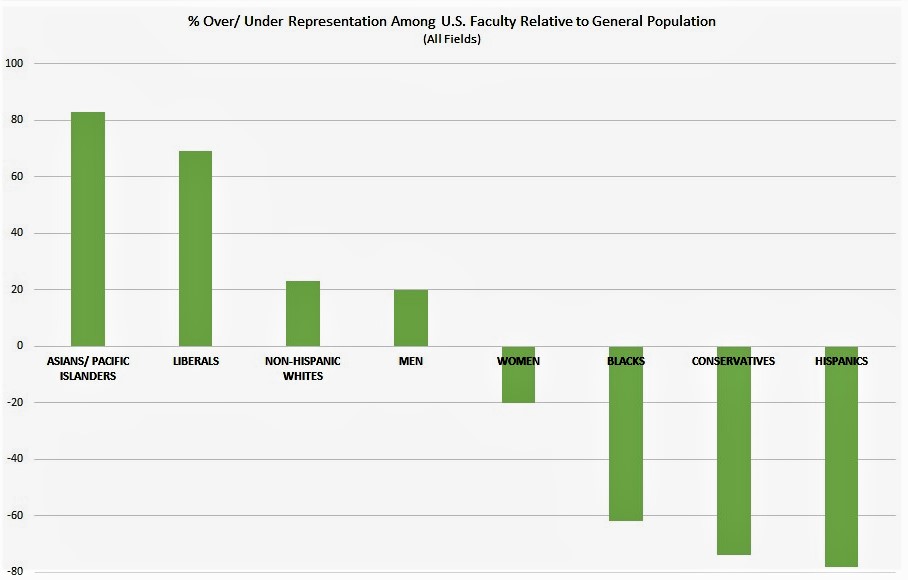Education
In Social Research Fields, Conservatives Are the Most Underrepresented Group
The lack of ideological diversity seems to be vastly more pronounced in social research fields than underrepresentation in terms of gender, sexuality, and race.

There is general social agreement that discrimination on the basis of gender, sexuality or race is wrong – and that increasing diversity along these lines is good.
Ideological diversity? Not so much.
In fact, while noteworthy progress has been made since the 90s in terms of representation for women and ethnic or racial minority groups, the ideological underrepresentation problem is actually growing worse. These trends have had significant negative impacts on the quality and impact of social research.
Yet, even for those who recognize that the lack of ideological diversity is a problem – many are unsure how the scale of this challenge compares to, say, (under)representation of racial, sexual or gender minorities.
This is both an empirical question and a normative question. Here, I will address the former dimension by comparing rates of faculty identification across different identity measures (for interested readers, my thoughts on the moral and practical aspects of the question are available in a new essay for the Times Higher Education).

Overrepresented Groups
With regards to race, research has shown that whites and Asians are overrepresented among tenured faculty. In terms of gender, men are overrepresented among full-time tenured faculty, while women tend to be concentrated in adjunct or otherwise non-tenured positions. Lesbians and gays are also overrepresented among faculty, especially in social research fields.
Progressives are vastly overrepresented in the academy. According to the most comprehensive study on faculty political leanings to date (Gross & Simmons 2014), progressives outnumber conservatives by 10:1 in the humanities and social sciences, despite the fact that conservatives outnumber liberals in the general U.S. population (and pretty much always have).
Comparing Underrepresentation Rates
In order to more easily compare levels of underrepresentation among groups, we can create a common representation quotient by dividing the percentage of representation each group has among full-time faculty divided by the share these groups comprise of the total U.S. population.
On this scale, approaching “1” would signal parity between representation in the academy v. the broader society. Exceeding “1” would indicate overrepresentation, while approaching “0” would indicate increasingly severe underrepresentation. In descending order, the breakdown is as follows:

| Group | Share of the U.S. Professoriate | Percentage of the U.S. Population | Representation Quotient | Source(s) |
| Asians & Pacific Islanders | 11 | 6 | 1.83 | U.S. Census Bureau, Myers 2016 |
| Liberals | 44 | 26[*] | 1.69 | Gross & Simmons 2014, Gallup 2018 |
| Whites | 75 | 61 | 1.23 | U.S. Census Bureau, Myers 2016 |
| Men | 59 | 49 | 1.2 | U.S. Census Bureau, Steiger 2013 |
| Women | 41 | 51 | 0.8 | U.S. Census Bureau, Steiger 2013 |
| Blacks | 5 | 13 | 0.38 | U.S. Census Bureau, Myers 2016 |
| Conservatives | 9 | 35 | 0.26 | Gross & Simmons 2014, Gallup 2018 |
| Hispanics | 4 | 18 | 0.22 | U.S. Census Bureau, Myers 2016 |
This is the picture for U.S. colleges and universities overall. However, if we restrict our analysis to social science fields, the dynamic changes dramatically:

| Group | Share of the U.S. Social Science Professoriate | Percentage of the U.S. Population | Representation Quotient | Source(s) |
| Liberals | 58 | 26 [*] | 2.23 | Gross & Simmons 2014, Gallup 2018 |
| Whites | 81 | 61 | 1.33 | U.S. Census Bureau, National Science Foundation |
| Asians & Pacific Islanders | 7 | 6 | 1.17 | U.S. Census Bureau, National Science Foundation |
| Men | 50 | 49 | 1.02 | U.S. Census Bureau, Ginther & Khan 2015 |
| Women | 50 | 51 | 0.98 | U.S. Census Bureau, Ginther & Khan 2015 |
| Blacks | 5 | 13 | 0.38 | U.S. Census Bureau, National Science Foundation |
| Hispanics | 4 | 18 | 0.22 | U.S. Census Bureau, National Science Foundation |
| Conservatives | 5 | 35 | 0.14 | Gross & Simmons 2014, Gallup 2018 |
Looking at underrepresented groups: Women are even closer to parity in social research fields than in most other academic sectors. And while blacks and Hispanics are severely underrepresented among full-time faculty in the academy writ large, those faculty that are black and/or Hispanic tend to be heavily concentrated in social research fields (at the expense of STEM fields). However, there also happen to be more faculty employed in social research than most other occupational fields. Therefore, the representation quotients for blacks and Hispanics remain roughly unchanged, regardless of whether we are talking about social research fields in particular, or U.S. institutions of higher learning overall.
However, there is a significant downward shift in levels of ideological representation when we restrict our analysis to social research fields. The representation quotient for conservatives in social science fields is 0.14, which is significantly lower than any other major population group measured. In other words, the lack of ideological diversity seems to be vastly more pronounced in social research fields than underrepresentation in terms of gender, sexuality, and race.
A version of this article was originally published by Heterodox Academy






